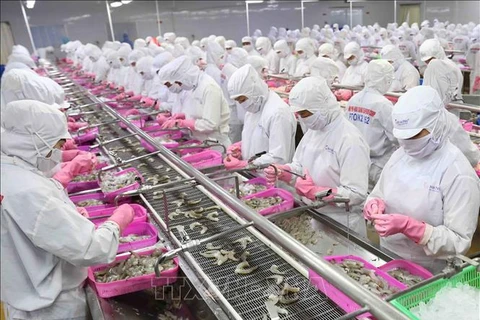Hanoi (VNA)- HSBC Global Research has just released the “Vietnam at a glance” report for July 2022, updating key forecasts for the Vietnam market.
Accordingly, HSBC has raised its growth forecast for Vietnam in 2022 to 6.9%, instead of the previous 6.6%. The bank also lowered Vietnam's growth forecast for the full year of 2023 to 6.3% from 6.7%.
According to HSBC, like many other countries, the risks of Omicron mutation are gradually disappearing coupled with easing restrictions, creating the basis for Vietnam to return to normal.
According to the HSBC report, after two quarters of stable reopening, Vietnam’s economic recovery continues to be an outstanding example in the region. Its GDP growth in the second quarter hit 7.7% year-on-year, easily exceeding market expectations (HSBC: 5.8%; research institutions: 5.9%). This is also the highest quarterly GDP growth Vietnam has ever achieved since 2011, thanks to a strong economic recovery across a wide range of sectors.
Thanks to the lifting of important domestic and international restrictions in mid-March, the tourism-related sectors, especially transportation and accommodation, have begun to flourish. Meanwhile, the retail sector in the second quarter of 2022 jumped 17% year-on-year, a sign that household consumption has recovered.
The textile and garment, footwear and machinery industries all recorded consistent growth, proving that Vietnam's external dynamics are returning.
The success is partly due to the gradual recovery of the labor market. The unemployment rate fell to 2.3% in the second quarter of 2022, while the number of jobs continued to grow close to pre-pandemic levels.
Besides recovering domestic demand, Vietnam's production has affirmed its leading position. All indicators show steady production growth.
One bright spot that helps Vietnam to protect itself against external risks is a stable FDI source, which helps create a fulcrum for the basic balance. FDI inflows into the manufacturing sector continued to increase, reflecting investor interest and unwavering confidence in Vietnam's fundamentals.
But upon closer analysis, another hidden message also emerges. Although overall growth is very positive, the energy crisis has begun to affect the country’s growth.
According to HSBC, the impact from high energy prices is becoming more and more obvious. On the one hand, the escalation of commodity prices that led to a trade deficit in the second quarter could worsen the already negative situation of the current account. On the other hand, even though household consumption has recovered steadily, high oil prices will likely lighten people's pockets and slowing recovery in the past time. In fact, price pressures have begun to manifest, although still at a manageable level compared to other countries in the region.
HSBC believes that inflation will surpass 4% from the fourth quarter of 2022 to the second quarter of 2023, requiring the State Bank to start normalizing monetary policy. The State Bank forecasts an interest rate increase by 50 basis points from the third quarter of 2022 and increase by 50 basis points each quarter until the third quarter of 2023. Thus, by the end of 2023, the regulatory interest rate could be up to 6.5%.
“Vietnam benefits from reopening its economy. Domestic demand is returning while external dynamics continue to be favorable. However, Vietnam should be cautious of increasing risks to growth, especially risks from escalating energy prices,” HSBC expert emphasized./.























